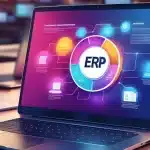In today’s fast-paced business environment, efficiency and streamlined processes are all-important. Enterprise Resource Planning (ERP) systems have become essential tools for managing various business functions seamlessly. However, many companies find themselves overwhelmed when choosing the right ERP system.
ERP systems integrate various business processes into a unified platform, addressing the inefficiencies caused by fragmented systems. Without an ERP, businesses face data silos, manual processes, and inconsistent information, leading to operational delays and errors.
According to the ERP Market Report, implementing ERP systems has significantly enhanced business processes for an overwhelming 95% of companies. By integrating various functions into a cohesive system, businesses have experienced improved accuracy better decision-making capabilities, and demonstrated the transformative impact of ERP solutions across diverse industries.
This article will help you simplify the selection process, providing clear and actionable steps for businesses to find an ERP system that suits their needs.
Table of Contents
What is ERP (Enterprise Resource Planning) System?
ERP stands for Enterprise Resource Planning. It is an integrated software platform used by organizations to manage and automate many of the business processes across various departments. Think of an ERP software as the digital backbone that connects various departments, ensuring they communicate effectively and work harmoniously.
An ERP system consolidates these functions into a single and unified system, from finance and human resources to supply chain management and customer relations. By consolidating these functions into a unified system, ERPs enable seamless information flow across different departments, improving coordination, efficiency, and decision-making.
Choosing the right Enterprise Resource Planning (ERP) system is crucial for a business because it integrates various functions into a single cohesive system, improving efficiency, accuracy, and decision-making.
On the contrary, choosing the wrong ERP can lead to significant challenges, including implementation failure, wasted resources, and operational disruptions, which can cause financial losses, and require costly and time-consuming repairs or replacements.
9 Tips for Choosing the Right ERP for Your Business
Choosing the best ERP software can be time-consuming, so having a plan is best. The following list of 8 tips will help you start on the right track. Following these tips, most businesses can choose ERP systems in the Philippines that best suit their needs.
Tip 1: Assess your business needs
The first step in choosing the perfect ERP system is thoroughly assessing your business needs. Understand your company’s unique challenges and identify the areas where an ERP system can provide the most significant improvements.
This involves evaluating current processes, pinpointing inefficiencies, and determining which functions need integration. Understanding your business requirements will help you narrow down the ERP options that best address your needs.
Look for systems that provide comprehensive modules tailored to your industry, whether it’s manufacturing, retail, or service-based. Ensure the ERP can handle all critical functions such as finance, human resources, supply chain management, asset management, and customer relationship management (CRM).
Besides that, choose an ERP with features that suit your business needs. Ineffective features can complicate and inefficient the integration process, resulting in wasted time and resources.
Additionally, consider opting for a cloud ERP solution. Cloud ERPs offer greater flexibility, scalability, and accessibility, allowing your team to access critical business information from anywhere with an internet connection.
Tip 2: Set clear objectives and goals
Once you’ve assessed your business needs, setting clear objectives and goals for your ERP implementation is crucial. What do you hope to achieve with the new system? Are you looking to improve inventory management, enhance customer service, or streamline financial reporting?
Defining your goals will help you select the right system and provide a benchmark for measuring the success of the ERP implementation. Ensure these goals are specific, measurable, achievable, relevant, and time-bound (SMART).
Tip 3: Consider user-friendliness and ease of integration
An ERP system should be user-friendly and easily integrated with your existing software. A complex, difficult-to-use system can lead to low adoption rates and hinder productivity. Look for an intuitive interface and robust support materials, such as user manuals and training videos.
Additionally, ensure the ERP system can seamlessly integrate with other tools your business relies on, such as CRM systems, e-commerce platforms, and accounting software. This integration will facilitate smoother data flow and reduce the risk of errors.
HashMicro’s ERP system is one of the most user-friendly options available. With its intuitive interface and comprehensive support materials, including user manuals and training videos, HashMicro ensures a smooth onboarding process and high user adoption rates.
Tip 4: Review vendor reputation and support
Choosing a reputable vendor with strong support services is crucial for the long-term success of your ERP implementation. Research potential vendors thoroughly, looking at customer reviews, case studies, and industry reputation.
Consider how long they have been in business and their experience in your industry. Additionally, evaluate their support services. Reliable customer support, including training, troubleshooting, and regular updates, is essential for maintaining the ERP system and addressing any issues that arise.
Hashmicro ERP is one of highly experienced vendor, trusted by over 1,750 clients across Southeast Asia. Renowned for its robust and reliable enterprise resource planning solutions, Hashmicro has established a strong reputation in the region.
Tip 5: Evaluate cost and ROI
Cost is a significant factor in choosing an ERP system. However, it’s important to consider the value and return on investment (ROI) rather than just the initial expense. Calculate the total cost of ownership, including software, hardware, implementation, training, and maintenance.
Then, weigh this against the potential benefits and savings the ERP system can bring to your business. An effective ERP system should ultimately provide a positive ROI by improving efficiency, reducing costs, and driving growth.
Now that you’re considering the long-term value and ROI of our ERP system, the next step is to understand the total investment required to achieve your business goals. Calculate your total cost of ownership and start planning for success.
Tip 6: Plan for implementation and training
A successful ERP implementation requires careful planning and thorough training. Develop a detailed implementation plan that outlines timelines, responsibilities, and milestones. Involve key stakeholders from different departments to ensure a smooth transition.
Training is also critical; ensure your team is well-equipped to use the new system effectively. Comprehensive training programs will help employees adapt to the new system quickly, minimizing disruptions to your business operations.
Tip 7: Seek recommendations and conduct demos
Finally, seek recommendations from other businesses and industry experts with ERP systems experience. Their insights can provide valuable perspectives and help you avoid potential pitfalls. Additionally, conduct demos of shortlisted ERP solutions.
Demos allow you to see the system in action, assess its usability, and determine if it meets your business needs. Involve end-users in the demo process to gather feedback and ensure the system fits your team well.
If you’re curious about how an ERP system works to streamline your business, you can find out how HashMicro meets your business needs by testing it through a free demo.
Tip 8: Choose an ERP with guaranteed security
Ensuring robust security in your ERP system is critical for protecting sensitive business data and maintaining customer trust. An ERP with guaranteed security features would help safeguard against cyber threats and data breaches.
In addition, compliance with industry standards and regulations, such as ISO/IEC 27001. This ensures that your ERP system not only protects data, but also complies with legal requirements and best practices. For example, Hashmicro, a leading ERP provider, complies with these standards, guaranteeing that their systems are secure and compliant.
Tip 9: It supports your overall business growth
An ERP system that supports your business growth is vital for long-term success. As your business expands, the ERP must be scalable, capable of accommodating increased transaction volumes, and adaptable to evolving operational needs.
Choosing an ERP with growth support allows for seamless integration of new functionalities, geographical expansion, and adaptation to market changes, positioning your business to thrive in a competitive landscape and capitalize on new opportunities.
Opting for an ERP that offers unlimited user licenses ensures that as your team grows, every member can access and contribute to the system without incurring additional costs, thus facilitating collaborative growth and operational coherence.
Consequences of Choosing the Wrong ERP
Selecting an unsuitable ERP system can have far-reaching negative implications for a business. The wrong choice can lead to significant disruptions in daily operations, causing delays and inefficiencies.
An ill-fitting ERP system can demoralize employees through complicated processes and insufficient support. This can result in reduced productivity and morale. Ultimately, these factors can reduce a company’s competitive advantage and undermine its ability to meet strategic objectives.
Financially, it can result in wasted investment and unexpected costs for additional customizations or even total replacement. Implementing an ERP system is a significant financial commitment, and if it fails to meet business needs, companies may need to invest additional resources in customizing the software or replacing it entirely.
Why Hashmicro is The Best Choice for Your Bussiness
HashMicro ERP is the ultimate solution for your business needs. It stands out in the competitive landscape by catering to diverse clients across various Asian industries, demonstrating its versatile and adaptable solutions.
Some of the advantages of Hashmicro include:
- Built-in Business Intelligence (BI): HashMicro ERP comes with integrated BI tools that provide real-time insights and analytics, empowering you to make data-driven decisions swiftly and accurately.
- Easy Integration with Other Systems: The system seamlessly integrates with various other platforms, ensuring a smooth and uninterrupted flow of information across all your business applications.
- 100% Unlimited Users: Enjoy the freedom of adding an unlimited number of users without any additional costs, making it perfect for growing teams and scaling businesses.
- Intuitive and User-Friendly Interface: HashMicro ERP is designed with a focus on user experience. It features an intuitive and easy-to-navigate interface, minimizing the learning curve and enhancing productivity.
- Accessible on Any Device: With HashMicro ERP, you can stay connected and manage your business from anywhere. It is accessible on desktops, tablets, and mobile devices, ensuring flexibility and convenience.
- Highly customizable and configurable: Can be customized to the business’s specific needs.
By leveraging HashMicro ERP, you’ll unlock a level of customization and efficiency that sets you apart from competitors.
With its tailored modules, seamless integration capabilities, and scalable architecture, HashMicro ERP empowers your business to optimize workflows, streamline processes,
Try the free demo now to see how our ERP system can enhance your business’s efficiency and productivity.
Conclusion
Choosing the perfect ERP system is a critical decision that can significantly impact your business’s efficiency and growth. You can make an informed choice by assessing your business needs, setting clear objectives, evaluating features, considering user-friendliness, reviewing vendor reputation, evaluating cost and ROI, planning for implementation and training, and seeking recommendations.
Choosing the right ERP system will streamline your operations, enhance productivity, and provide a solid foundation for future growth. By following this comprehensive guide, you can confidently navigate the selection process, ultimately laying the foundation for improved efficiency, productivity, and growth within your business.
Transform your business operations with HashMicro’s ERP System, a comprehensive solution designed to centralize management, automate workflows, and provide real-time insights for enhanced efficiency and growth. Empower your business with HashMicro’s ERP System, setting new standards for efficiency, scalability, and success.
Click the banner below to schedule a free demo, and do not hesitate to contact our team with any inquiries.


























